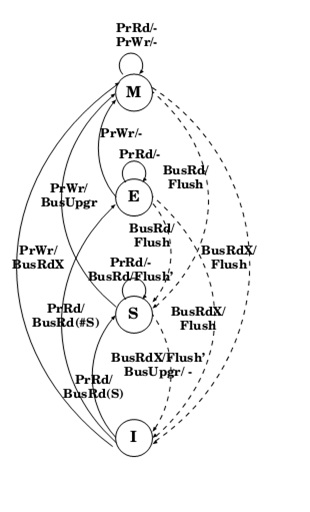CSC/ECE 506 Spring 2010/8a sk: Difference between revisions
(→MESI) |
No edit summary |
||
| Line 20: | Line 20: | ||
= MESI = | = MESI = | ||
MESI protocol is a 4-state protocol, in which a cache block can have an 'Exclusive' state apart from the Modified, Shared and Invalid state as in MSI protocol. [[File:MESI-sk.jpg| | MESI protocol is a 4-state protocol, in which a cache block can have an 'Exclusive' state apart from the Modified, Shared and Invalid state as in MSI protocol. [[File:MESI-sk.jpg|thumbnail|State Transition Diagram for MESI protocol]] | ||
*Modified : The cache block is dirty, and the value has to be written back to main memory upon eviction. | *Modified : The cache block is dirty, and the value has to be written back to main memory upon eviction. | ||
*Exclusive : The variable is only in this cache and the value matches with that in the memory, that is, it is clean. | *Exclusive : The variable is only in this cache and the value matches with that in the memory, that is, it is clean. | ||
Revision as of 01:02, 19 March 2012
Introduction
MSI
MSI protocol is a three-state write-back invalidation protocol which is one of the simplest and earliest-used snooping-based cache coherence-protocols. According to this protocol, a cache block can be in one of the Modified (M), Shared (S), and Invalid (I) states.

- Modified state indicates that the variable in the cache has been modified and therefore has a different value from that found in the main memory. A cache line in this state thus needs to be written back to the block to memory during eviction.
- Shared state indicates that the block exists in one or more caches, and is clean, implying that its value is consistent with the one in main memory. So a cache block in this state can be evicted without having to write it back to the main memory.
- Invalid state indicates that the cache block is invalid.
In MSI protocol, processor requests to the cache include:
- PrRd: Processor requests read to a cache block.
- PrWr: Processor requests write to a cache block.
In MSI protocol Bus-side requests include:
- BusRd: BusRd transaction is generated by a PrRd that misses in the cache, and the processor expects a data response as a result. The cache controller puts the address on the bus and asks for a copy that it does not intend to modify. The memory supplies the data.
- BusRdX: BusRdX transaction is generated by a PrWr to a block that is either not in the cache or is in the cache but is not in modified state. The cache controller puts the address on the bus and asks for an exclusive copy that it intends to modify. The memory system provides the data. All other caches are invalidated. Once the cache obtains the exclusive copy, the write can be performed in the cache.
- Flush: Flush is a snooped request that indicates that an entire cache block is written back to the main memory by another processor.
The three states in the MSI protocol are used to directly enforce the cache coherence by allowing only a single processor in the modified state at a given time, allowing multiple processors in the shared state concurrently, and disallowing other processors in the shared state while a processor is in the modified state. In the MSI system, there is a serious drawback that an explicit BusRdX transaction is required for a read followed by a write, even if there are no other shared copies. When a processor reads in and modifies a data item, two bus transactions are generated in this protocol even in the absence of shared copies. The first is a BusRd that gets the cache block to S state, and the second is a BusRdX(or BusUpgr) to invalidate other cached copies. The BusRdX is useless in case there are no other shared copies.
SGI(Silicon Graphics, Inc) had used a protocol much like MSI in the IRIS 4D multiprocessor series. The bus used in this workstation is a pipelined, block transfer bus that supports the cache coherence protocol. The 4D-MP graphics superworkstation brought 40 MIPS(million instructions per second) of computing performance to a graphics super workstation. The cache coherence protocol had to support synchronization as well as sharing, so improvement in efficiency operations necessitated a compromise in the efficiency of the data sharing protocol. With the simple rules of MSI protocol enforced by hardware, efficient synchronization and efficient data sharing are achieved in a simple shared memory model of parallel processing in the 4D-MP graphics super workstation. So the simple MSI protocol is well-suited to these needs.
MESI
MESI protocol is a 4-state protocol, in which a cache block can have an 'Exclusive' state apart from the Modified, Shared and Invalid state as in MSI protocol.

- Modified : The cache block is dirty, and the value has to be written back to main memory upon eviction.
- Exclusive : The variable is only in this cache and the value matches with that in the memory, that is, it is clean.
- Shared : The variable exists in atleast one cache and is clean.
- Invalid : The value of the variable has been modified by another cache and this value is invalid; the cache must now read a new value from main memory or another cache